Aspen Tree
- October 4, 2023
- 0 comment
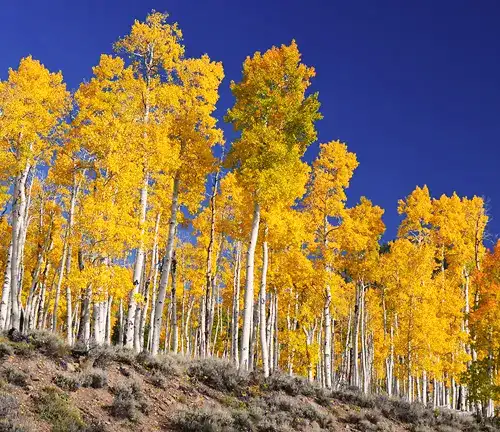
The Aspen tree, scientifically known as Populus tremuloides, stands as a captivating emblem of North American landscapes. With its smooth white bark etched by unique black scars and rounded leaves that tremble even in the slightest breeze, the Aspen is often affectionately called the “quaking aspen.” Thriving in cooler regions, particularly the Rocky Mountains, this deciduous tree frequently forms extensive groves with an interconnected root system. One remarkable aspect of the Aspen lies in its reproductive strategy, employing both sexual reproduction through seeds and asexual reproduction through suckers, leading to the creation of genetically identical clones and vast colonies.
Ecologically, Aspen groves play a pivotal role in supporting biodiversity. These groves provide essential habitats for a range of wildlife, including elk, deer, and small mammals, contributing to the overall health and balance of forest ecosystems. The Aspen’s versatility extends beyond its ecological significance; its lightweight and adaptable wood finds applications in industries such as paper production and woodworking. Additionally, the visual spectacle of Aspen’s leaves transitioning to brilliant gold in the fall adds a breathtaking touch to autumn landscapes, enhancing its appeal not only to nature enthusiasts but also to those who appreciate the cultural significance of this iconic tree.

However, the Aspen faces various challenges, including habitat fragmentation and susceptibility to certain diseases. Conservation efforts are crucial to preserving these remarkable trees and maintaining the delicate balance they bring to ecosystems. The Aspen, with its aesthetic allure, ecological importance, and cultural significance, continues to be a symbol of resilience and natural beauty across North America.
| Characteristic | Description |
| Scientific Name | Populus tremuloides |
| Lifespan | Generally has a lifespan of 60 to 70 years, although some trees can live for over 100 years under favorable conditions. |
| Habitat | Native to North America, especially the Rocky Mountains; forms groves with interconnected roots. |
| Bark | Smooth, white bark with black scars; protects against sunscald; visually striking. |
| Size | Medium-sized tree, 20 to 80 feet in height; trunk diameter 1 to 2 feet. |
| Soil Stabilization | Root system helps prevent soil erosion, contributing to the stability of landscapes. |
| Root System | Extensive root system facilitates asexual reproduction; supports grove structure. |
| Climate Tolerance | Cold-hardy; adapts to a range of climates but thrives in cooler regions with distinct seasons. |
| Disease Resistance | Susceptible to certain diseases, including cankers and rust, which can impact tree health. |
| Water Source Dependency | Often found near water sources; has a high water demand, contributing to riparian ecosystems. |
A Brief History
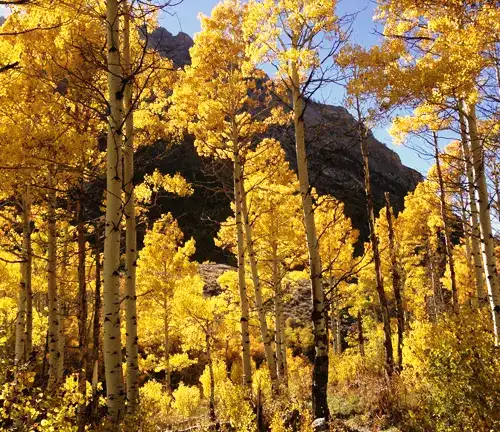
The Aspen tree, scientifically known as Populus tremuloides, has a rich and storied history that stretches across continents and time. Native to North America, the Aspen has been witness to the ever-changing landscapes and has played a crucial role in the ecosystem for centuries. Named for the quivering movement of its leaves in the slightest breeze, the Aspen has been both a silent observer and an active participant in the ecological tapestry of the regions it inhabits.
Color and Appearance
The iconic aspen tree (Populus tremuloides) is renowned for its distinctive color and appearance, captivating observers with its striking visual allure. During spring and summer, the aspen’s leaves unfurl in a vibrant, luscious green, creating a dense and verdant canopy that rustles gently in the slightest breeze. The leaves themselves are typically round and feature a finely serrated edge, lending the tree an overall soft and delicate appearance. Come autumn, however, the aspen undergoes a breathtaking transformation. The leaves transition into a palette of warm hues, ranging from brilliant gold and sunny yellows to rich oranges and fiery reds. This dazzling display of colors turns the aspen groves into a natural masterpiece, attracting photographers, artists, and nature enthusiasts alike. Yet, it’s not just the leaves that contribute to the aspen’s allure.
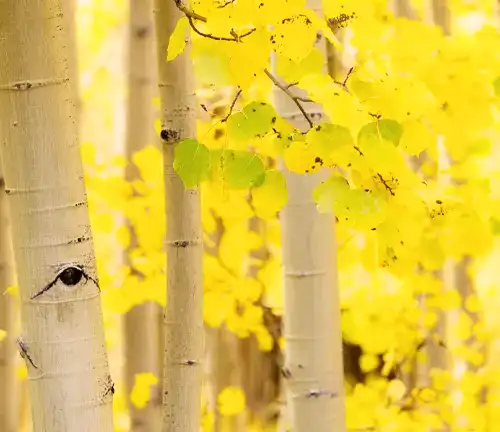
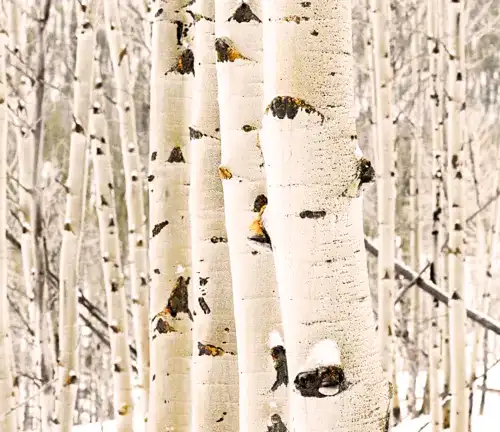
The tree’s bark adds a unique touch – smooth and creamy white, it starkly contrasts with the surrounding forest landscape. This distinctive feature not only sets the aspen apart visually but also serves as a signature characteristic, making it instantly recognizable in various ecosystems. Overall, the color and appearance of the aspen tree create a captivating spectacle that evolves with the seasons, ensuring it remains an enduring symbol of natural beauty throughout the year.
Unique Features
One of the most distinctive features of the Aspen tree is its remarkable bark, which boasts a smooth, chalk-white surface adorned with unique black scars. The quaking or trembling leaves, owing to their flattened petioles, create a mesmerizing visual effect, especially during the fall when they turn vibrant shades of yellow and gold. This iconic feature has made the Aspen a beloved and recognizable tree in various landscapes.
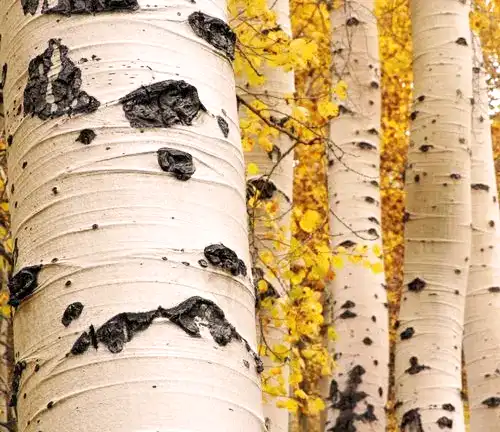
Ecological Importance
The Aspen tree is a keystone species, meaning its presence significantly influences the entire ecosystem. Its groves provide habitat and sustenance for a diverse array of wildlife, from insects to large mammals. Additionally, the unique ability of Aspens to regenerate rapidly makes them crucial for stabilizing soil and preventing erosion.
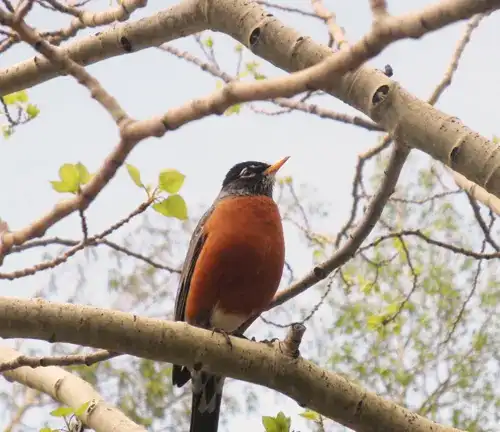

Adaptation and Resilience
The Aspen tree, with its quivering leaves and distinctive white bark, epitomizes a tale of adaptation and resilience. In environments ranging from boreal forests to arid mountains, Aspen trees demonstrate an unparalleled ability to thrive in diverse climates and soil conditions. Their finely tuned adaptation to sunlight ensures dominance in open, sunlit landscapes. Beneath the surface, Aspen groves exhibit resilience through clonal reproduction and rapid growth, swiftly recovering from disturbances. Symbiotic relationships with mycorrhizal fungi further enhance their ability to navigate nutrient-poor soils. Aspen trees, despite facing challenges such as diseases, possess formidable defense mechanisms, compartmentalizing infections. Their adaptability to disturbances, both natural and human-induced, underscores a tenacity that defines their role as dynamic navigators in the ever-changing landscapes of nature. In the dance of survival, Aspen trees stand as ecological marvels, embodying a narrative of adaptation, resilience, and enduring charm.
Cultivation and Care
Aspens are hardy trees, that adapt to a wide range of soil types and climates. They are commonly propagated through their root system, forming expansive groves known as clones. Understanding their preference for sunlight and well-drained soil is crucial for successful cultivation. With proper care, these trees can thrive in both urban landscapes and wilderness settings.

Life Cycle
The life cycle of the Aspen is a fascinating journey of renewal. The trees typically reproduce both sexually, through seeds, and asexually, through the growth of root suckers. This dual reproductive strategy contributes to the resilience and longevity of Aspen groves, ensuring their continued presence in various landscapes.
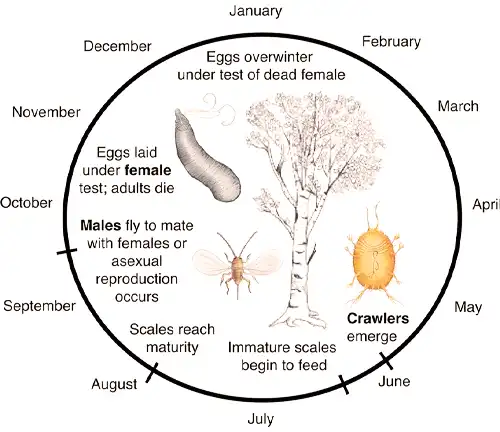
Cultural and Historical Significance
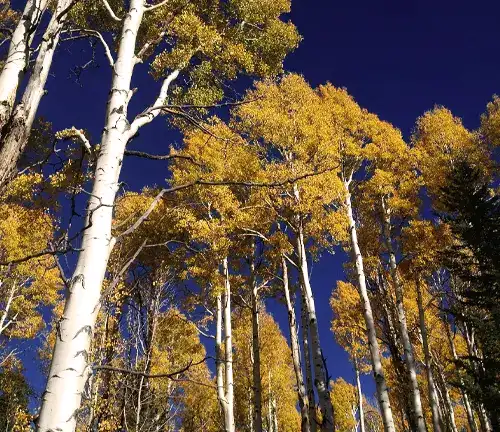
Throughout history, the Aspen tree has held cultural and historical significance for various indigenous communities. Its wood has been used for crafting tools, while its bark has found applications in traditional medicine. Symbolizing resilience and adaptability, the Aspen features prominently in folklore and rituals of native cultures.
Wood Products and Applications
The wood of the Aspen tree is valued for its light color and fine grain. While not as dense as some hardwoods, it finds applications in furniture, paneling, and other woodworking projects. Its versatility extends to paper production, making it a valuable resource in the pulp and paper industry.


Other Uses
- Timber. Aspen wood is lightweight and strong, so it is popular for making shipping boxes, plywood, and furniture.
- Paper. Aspen’s strong pulp is inexpensive, easy to peel, and it bleaches well, so it is a popular choice for paper production.
- Food Industry. The benzoic acid in aspen leaves is used to preserve foods.
- Pharmaceutical industry. Because of its analgesic, aspirin-like properties, extracts of aspen are used in the production of pharmaceutical products.
- Fungicide. Aspen buds contain p-hydroxybenzoic acid, which is used in the production of fungicides.
- Dye. The catechol from the bark has commercial applications in photography and dyeing.
- Personal care. Aspen bark extract is also an ingredient in cosmetics.
Threats and Conservation
Despite its resilience, the Aspen tree faces threats from various factors, including climate change, disease, and overgrazing. Conservation efforts are crucial to preserving these iconic trees and the ecosystems they support. Sustainable forestry practices, habitat protection, and public awareness are essential components of Aspen conservation.
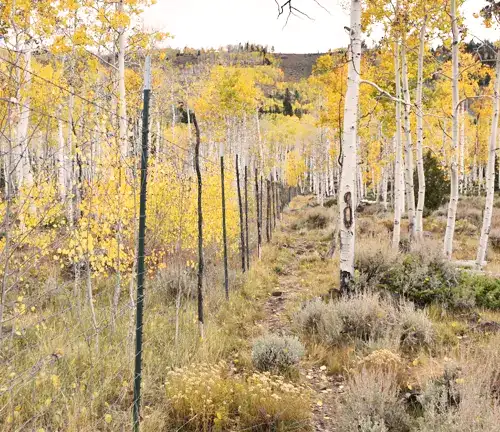
Benefits
The benefits of the Aspen tree are manifold. Its ecological role in providing habitat, preventing soil erosion, and contributing to biodiversity is immeasurable. The wood and bark of the Aspen have practical applications, and its aesthetic value adds to the allure of landscapes where it thrives.
Popular Beliefs about Aspen Tree
Aspen trees, with their quivering leaves and interconnected groves, embody a rich tapestry of symbolism across diverse cultures. Renowned for their adaptability, they symbolize resilience and the potential for renewal amid life’s changes. In European folklore, Aspen trees were planted as protective guardians against malevolent forces, their rustling leaves forming a shield against evil spirits. The spiritual significance of Aspen groves extends to beliefs in nature spirits residing within, creating enchanted spaces for communion with the mystical. Indigenous rituals incorporate various parts of the tree, emphasizing its ceremonial importance. The interconnected root systems of Aspen groves evoke ideas of sacred geometry, reflecting unity and interconnectedness. As the seasons change, so do the hues of Aspen leaves, symbolizing the cyclical nature of life, death, and rebirth. These beliefs weave a narrative that transforms Aspen trees from mere flora into living symbols, inviting us to listen to the ancient tales embedded in their leaves, roots, and branches.
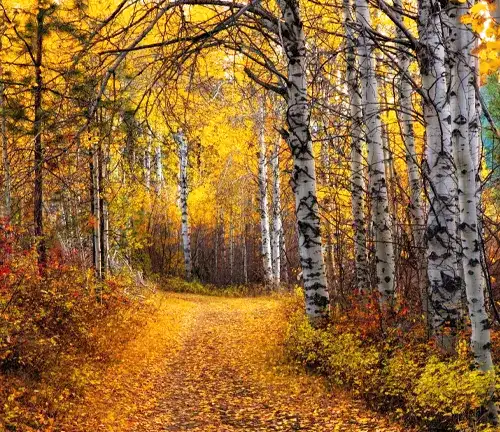
Common Species
European Aspen (Populus tremula)
Found in Europe and parts of Asia, this species is similar to the North American quaking aspen but has slightly different characteristics. It also exhibits trembling leaves and is an important component of European forests.
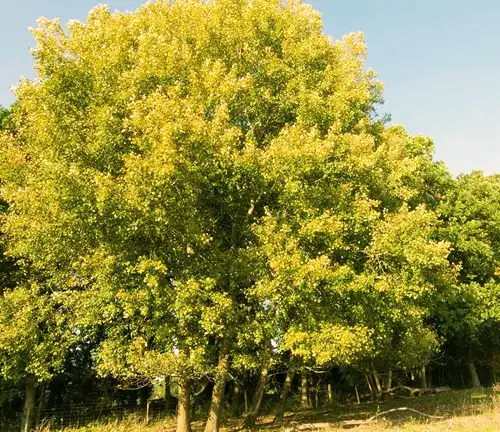
Bigtooth Aspen (Populus grandidentata)
Native to North America, bigtooth aspen is often found in eastern and central regions of the continent. It is named for its large, coarse teeth on its leaves, which distinguish it from quaking aspen.
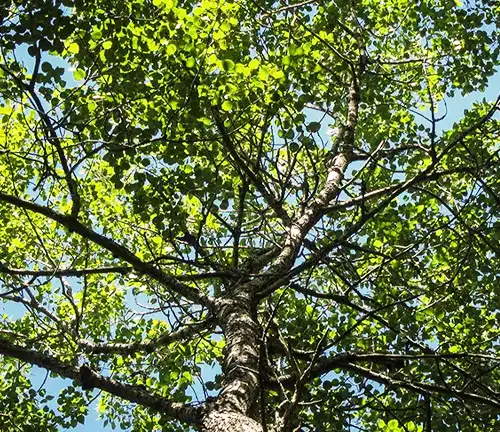
Chinese Aspen (Populus adenopoda)
Native to China, the Chinese aspen is adapted to the specific climatic conditions of its range. It has been used for various purposes, including timber and traditional medicine.
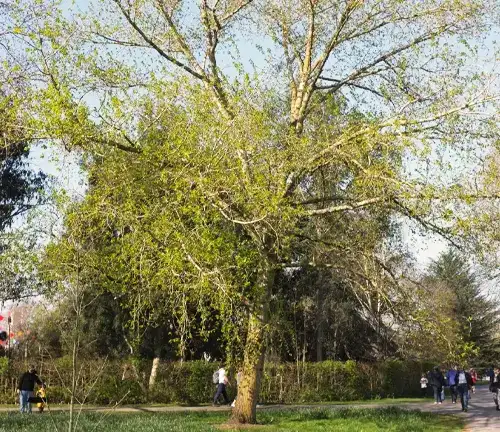
Japanese Aspen (Populus sieboldii)
Native to Japan and parts of China and Korea, this aspen species is appreciated for its attractive leaves and is sometimes cultivated as an ornamental tree.

Why Aspen Trees Are Called “Quaking Aspen”
The “quaking aspen,” scientifically known as Populus tremuloides, earns its name from the distinctive behavior of its leaves, which quiver or tremble in even the gentlest breeze. This phenomenon is attributed to the flattened petioles connecting the leaves to the tree’s branches. Beyond its enchanting visual appeal, this adaptation serves practical functions, acting as a defense mechanism against herbivores and maximizing sunlight exposure for enhanced photosynthesis. In groves, the synchronized movement of the leaves creates a captivating spectacle, particularly during the fall when the leaves undergo vibrant color transformations. The quaking Aspen’s cultural significance lies in its symbolic ties to change and resilience in indigenous folklore. Scientifically, researchers explore the biomechanics and physiology behind this unique leaf movement, contributing to a deeper understanding of ecological interactions. The name “quaking aspen” thus encapsulates not only a visual marvel but a dynamic expression of nature’s intricacies and adaptability.
The Whispers of an Ancient Aspen Symphony “Pando“
Nestled within Utah’s Fishlake National Forest, Pando, the quaking aspen grove, unveils a silent spectacle of interconnected wonders. Aptly named for its Latin meaning “I spread,” Pando is not a single tree but a vast clonal colony, sharing an ancient and expansive root system. The rhythmic dance of the quivering leaves, characteristic of aspen trees, takes on a deeper meaning within Pando—an ageless choreography that speaks to the harmonious interconnectedness of its trees. Estimating Pando’s age is a challenge, yet its roots are believed to have thrived for millennia, intertwining with comparatively short-lived individual stems. Despite its enduring charm, Pando faces modern challenges, prompting conservation efforts to preserve this extraordinary grove. Beyond its biological significance, Pando becomes a living metaphor for resilience and adaptability, inviting contemplation of the intricate threads that connect all life on Earth. In the quiet expanses of Fishlake National Forest, Pando stands as a timeless symphony of interconnected beauty, inviting observers to marvel at the enduring dance of nature through the ages.
Conclusion
In conclusion, the Aspen tree stands not only as a testament to the resilience of nature but also as a symbol of interconnectedness in ecosystems and human cultures. Understanding and appreciating the multifaceted nature of the Aspen is vital for its conservation and the preservation of the intricate web of life it sustains. As we continue to navigate the complexities of a changing world, the Aspen remains a steadfast companion, its leaves quivering in the breeze, a timeless embodiment of nature’s enduring grace.

Frequently Asked Questions (FAQs)
- Do all Aspen trees have white bark?
No, not all Aspen trees have white bark. While the quaking or trembling Aspen (Populus tremuloides) is famous for its chalk-white bark, there are other Aspen species with different bark colors, such as the European Aspen (Populus tremula), which has a grayish bark. - Why do Aspen leaves tremble?
Aspen leaves tremble due to their flattened petioles, which are flattened leaf stalks. This unique adaptation allows the leaves to flutter or quiver even in the slightest breeze, reducing water loss by limiting exposure to the wind and sunlight. - Are Aspen trees a single organism or individual trees?
Aspen groves are often considered one of the largest living organisms on Earth. Although individual Aspen trees appear separate, they often share a common root system and are connected underground. As a result, a grove of Aspen trees is essentially a single organism with numerous interconnected trunks. - Can you eat Aspen trees?
Yes, some parts of the Aspen tree are edible. Indigenous communities historically consumed the inner bark, known as cambium, as a source of sustenance. It’s important to note that harvesting bark from living trees can harm them, so responsible and sustainable practices should be followed. - Do Aspen trees only grow in North America?
While the quaking Aspen (Populus tremuloides) is primarily native to North America, there are Aspen species found in other parts of the world, including Europe and Asia. Each species may have unique characteristics and adaptations to its specific environment, contributing to the global diversity of Aspen trees.
In the enchanting realm of nature, the Aspen tree emerges as a silent poet, painting landscapes with its quivering leaves and adorned in a cloak of white bark. This arboreal marvel, with its dance in the wind, not only graces our surroundings but weaves tales of resilience and interconnectedness. As we stand amidst the aspen groves, let us pledge to be guardians of this living poetry, cherishing the delicate balance it embodies. In the whispers of the leaves, the Aspen beckons us to honor its legacy, a timeless reminder that our fates are entwined with the fate of the Earth.


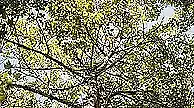

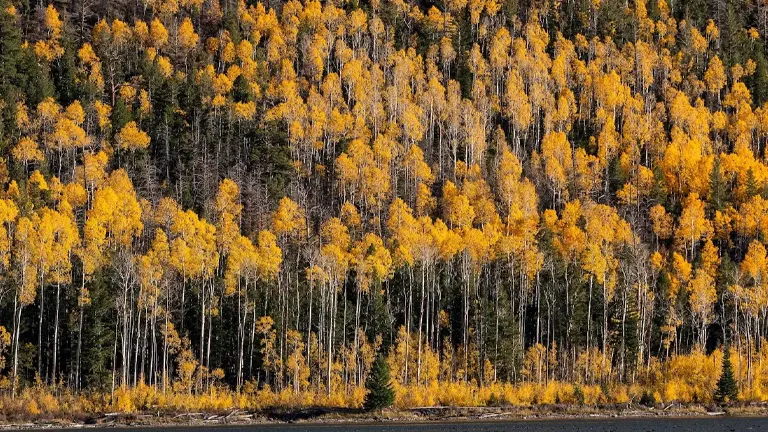
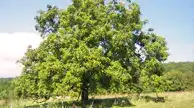

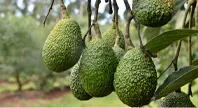

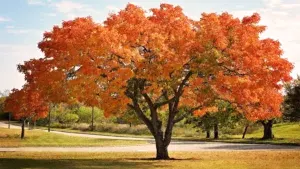
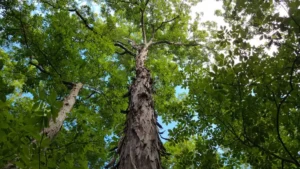

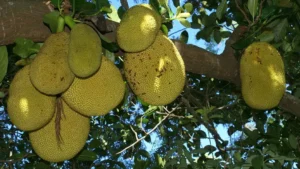
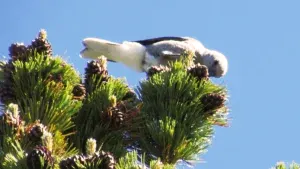
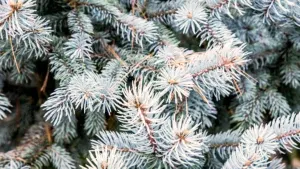
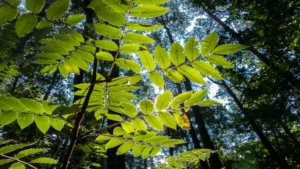

Leave your comment